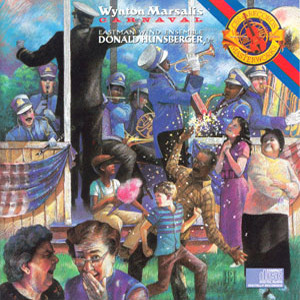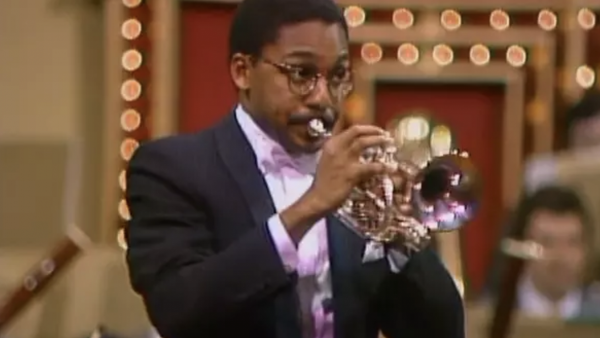Carnaval
The acclaimed Eastman Wind Ensemble, conducted by Donald Hunsberger, features Wynton’s sparkling cornet work in a program that includes music by Rimsky-Korsakov, Niccolo Paganini, Jean-Baptiste Arban (whose “Variations on ‘Carnival in Venice’ ” inspired the album’s title and typifies its buoyant mood), Herbert F. Clarke, Jules Levi, and the 18th century Irish composer Thomas Moore.
Check out the sheet-music book: Carnaval: 11 Solos for Cornet and Piano

Album Info
| Ensemble | Wynton Marsalis with Eastman Wind Ensemble |
|---|---|
| Release Date | March 17th, 1987 |
| Recording Date | September 13-14-15, 1985 |
| Record Label | CBS Masterworks |
| Catalogue Number | MK 42137 |
| Formats | CD, Digital Download, LP |
| Genre | Classical Recordings |
Track Listing
| Track | Length | Preview |
|---|---|---|
| Variations sur Le Carnaval de Venise – Jean-Baptiste Arban | 7:32 | Play |
| The Debutante (Caprice brillant) – Herbert L. Clarke | 5:48 | Play |
| Believe Me, If All Those Endearing Young Charms | 3:25 | Play |
| Grand Russian Fantasia | 6:21 | Play |
| Moto Perpetuo, Op. 11 | 4:30 | Play |
| Tis the last Rose of Summer | 1:48 | Play |
| The Flight of the Bumblebee from Tsar Saltan | 1:05 | Play |
| Napoli – Variations on a Neapolitan Song | 5:44 | Play |
| Fantaisie Brillante | 8:16 | Play |
| Sometimes I feel Like a Motherless Child | 3:21 | Play |
| Valse Brillante (Sounds from the Hudson) | 8:06 | Play |
Liner Notes
Around the turn of the twentieth century, the wind band was the primary medium for average Americans to hear music performed live. Bands were everywhere. Community ensembles were found in every size city and town; numerous industries and military regiments fostered band activity. Millions flocked to the amusement parks, state and industrial expositions and to local theaters to hear professional ensembles—directed by such luminaries as John Philip Sousa, Patrick S. Gilmore, Frederick Innes and Arthur Pryor—performing programs of marches, orchestral and operatic transcriptions, light-hearted incidental music, and, especially, to hear the numerous soloists featured on each concert.
The distinguished lineage of cornet soloists performing throughout America from the end of the Civil War through the 1920s included Gilmore, Matthew Arbuckle, Jules Levy, Ben Bent, Alessandro Liberati, Hermann Bellstedt, Herbert L. Clarke, Walter Emerson, Frank L. Simon, Edna White and Louise Horn. Many of these performers went on to found and direct their own professional bands.
The cornet was an outgrowth of technical developments emanating from the addition of valves to the natural trumpet. The design of the cornet, basically a conical bore instrument versus the cylindrical bore of the trumpet, provides it with a mellow, warm, rounded sound as opposed to the brilliance or cutting edge of the orchestral valved trumpet. It earned itself a position of prominence in wind bands and brass bands where music was written primarily in flat keys (versus the sharp keys that favor the string instruments in an orchestra) and where the sweeter sound of the instrument provided a satisfactory treble melodic line. Indeed, the principal requirements for a cornet solo included gracious melodic lines, simple harmonies and strong clear rhythms set in patterns that alternated the soloists with the accompanying band. The band would be featured in the introduction and in the “break strains,” short passages of contrasting material that set-up the soloists for his (or her) next variation or statement. In addition, cornetists performed encores that dazzled the audience with technical proficiency or lulled them into a sense of rapture through the sheer simplicity and beauty of a lovely slow melody presented in a warm singing manner. In this collection Wynton Marsalis performs three such slow, enchanting melodies.
Wynton possesses the same unique abilities to cross over the performance lines between various styles and techniques of performance that made the soloists listed above outstanding among their contemporaries. His technical command of the instrument is truly phenomenal in its consistency, resulting in dazzling displays of rapid tonguing and slurring. All this, however, is balanced by the warm melodic interpretive sense with which he approaches the music. The ability to continue performing while breathing (rotary or circular breathing) enables Wynton to continue melodic lines long past the time one would expect the air supply to diminish!
–Donald Hunsberger
The Eastman Wind Ensemble is the prototype of the contemporary wind band – utilizing a flexible instrumentation based upon the needs of the composer. Founded by Frederick Fennell and composed entirely of undergraduate and graduate students at the Eastman School of Music of the University of Rochester, the Ensemble is America’s most acclaimed wind band.
Donald Hunsberger, Conductor of the Eastman Wind Ensemble since 1965, is one of the leading authorities on wind repertoire and performance techniques in
America today. His diverse background includes a tour of duty with the United States Marine Band, Washington, DC, as trombone soloist and Chief Staff Arranger, and the co-authorship of a critically acclaimed text The Art of Conducting.
I would like to dedicate this album to the memories of George jansen and John Femandez, my high school trumpet instructors whose love for music continues
to inspire me. Special Thanks To: Donald Hunsberger and my new friends in the Eastman Wind Ensemble; and to William Fielder, John Longo, Delfeayo Marsalis, Ellis and Dolores Marsalis, Dr. Judith Stillman, Wilmer Wise and Ray Wright.
– Wynton Marsalis
Credits
Produced by Steven Epstein
Executiive producer: Christine L. Reed
Wynton Marsalis’ Personal Management: Edward C. Arrendell, II; The Arrendell Management Group; P.O. Box 55398; Washington, D.C. 20040.
Control engineer: Bud Graham
Remote technical supervisor: Hank Altman
Remix engineer: Tim Geelan
Edited by Tom MacCluskey
Recorded digitally using the Sony PCM 3324 Digjtal Recorder
Principal microphones: B&K 4003 (main array), Neumann KM 84, AKG 414 EB-P48
Monitor loudspeakers: B&W 801
Recorded in the Eastman Theater, The Eastman School of Music of the University of Rochester, Rochester, NY.
Cover design: Jo DiDonato
Cover art: Pamela H. Patrick.
Personnel
- Donald Hunsberger – conductor


